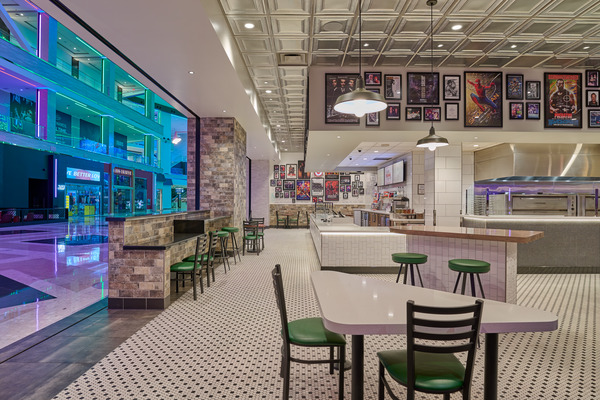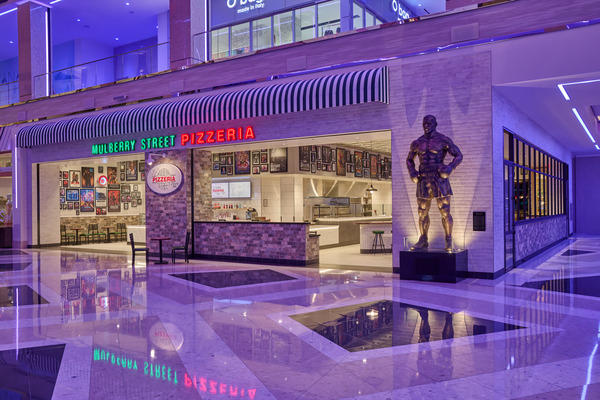A 10-Foot Mike Tyson Statue Helped One Restaurant Expand
4 Min Read By MRM Staff
When Beverly Hills-based New York-style Mulberry Street Pizza had the opportunity to expand its brand presence in Las Vegas, owner Richard Palmer wanted to ensure that the 2,655-square-foot space at Resorts World could efficiently accommodate an influx of guests and still serve up some Vegas pizazz alongside the slices. To accomplish that, Palmer turned to JCJ Architecture to lead the effort to transform the small-footprint venue into a dining destination complete with an Instagram-friendly 10-foot bronze statue of Mike Tyson at one of the three entrances.
Located in a prime location within The District, the L-shaped eatery features a state-of-the-art Blodgett pizza oven and memorabilia from Palmer’s personal collection within four main zones: an ordering area, a waiting area for pick-up orders, stand-up dining, and table dining at the perimeter. A display case of boxing and UFC championship belts sits at the far end of the restaurant for diners to peruse while they eat or wait to pick up their food. The white, black, red, and green color palette, inspired by traditional Bronx Italian pizzerias, is based on the original Mulberry Street Pizza venue in Beverly Hills, ensuring continuity across brand locations.
To learn more about the project, Modern Restaurant Management (MRM) magazine reached out to Rick Marencic, IIDA, Principal / Studio Leader at JCJ Architecture.
From an architectural and design standpoint, what are best practices for expanding a brand to a new location?
From the start, it’s critical to understand the origin of the idea fueling the restaurant’s concept. From there, you can maintain the look and feel, staying true to the owner’s vision. Equally, it’s important for designers to honor the brand while guiding new locations to adapt to specific markets and trends, creating a distinct, unique experience that separates itself while keeping a hold on that connection. Additionally, maintaining a keen eye on cost is key to mitigating unforeseen circumstances, balancing landlord incentives with owner budget while navigating escalating building and FF&E costs.
How do you maintain brand integrity through design?
The foundational element of maintaining brand integrity is avoiding tangential approaches, as they dilute the intention of the experience. Once again, paying close attention to staying on budget is crucial to meet initial expectations without sacrificing any foundational elements of the brand. Open lines of communication should also be established between all parties involved in the project to ensure everyone is aligned in reaching a cohesive final product.
When a brand like Mulberry is known for a certain ethos, how does design help it evolve and stay modern?
The overall approach of Mulberry Street Pizzeria is rooted in simplicity, drawing inspiration from the beloved popular culture of a New York pizzeria. Familiar materials and furnishings like penny tile, café chairs, and celebrity photos displayed family style combine to deliver a venue that is both classic and modern––emulating iconic elements of the original restaurant while feeling fresh and tailored to the location.

What was the process of working on this particular project and making the brand work in Vegas and connect with the existing environment?
Owner Richie Palmer’s focus on his celebrity milieu is a crowd pleaser and is a natural fit that marries elements of professional boxing, Hollywood, New York, and Las Vegas. From that perspective, our task was straightforward: convey the essence of Mulberry Street Pizzeria in an honest way through design.
Where did the idea of adding a Mike Tyson statue come from and what does it add to the ambiance?
Richie is a life-long boxing fan and wanted to celebrate Mike Tyson’s significance in Las Vegas and World Boxing history. He collaborated with the Resorts World team to obtain Tyson’s permission to create the statue, and from there our team coordinated with the expertise of JVA Art Group from San Diego to source a sculptor who understood the project goals and brought that vision to life.
What has the response been to the statue?
The initial opening of the restaurant generated some great publicity from the statue, drawing many to reminisce on the everlasting impression he left on the Las Vegas boxing community. The piece certainly catches the eye, luring attention before diners even set foot in the door of Mulberry Street Pizzeria.

What are some best practices for curated memorabilia elements that are authentic to the brand and location as well as engaging to the guest?
Sourcing authentic memorabilia is always a best practice. Richie Palmer has collected professional boxing, fighting, and celebrity memorabilia for his entire professional life, providing our team with an invaluable resource for outfitting the Las Vegas location. His approach is genuine––if he has an autographed movie poster, celebrity photo, or championship belt, he has met the person and knows who’s autographed it first hand. This unique sort of display is incredibly engaging for guests, creating a sort of museum experience that sparks curiosity from each diner. There are moments of discovery throughout, creating a space that guests want to return to over and over.
What are some design challenges of growing a brand in Las Vegas?
Our design needed to be durable to handle the large thru-put of Resorts World guests. We measured success based on our ability to navigate and address the needs of the owner, Resorts World, the construction schedule, and budget simultaneously.

